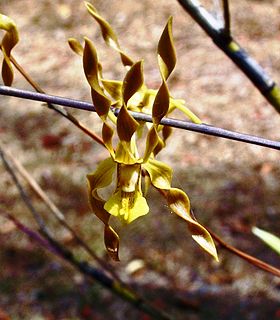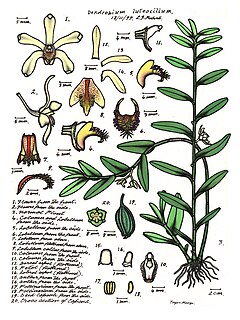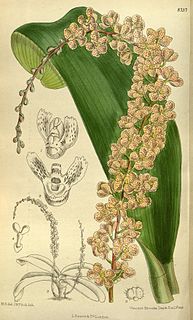
Dendrobium trilamellatum, commonly known as the fragrant tea tree orchid or large tea tree orchid, is a species of epiphytic orchid found in northern Australia and New Guinea. It has spindle-shaped pseudobulbs, between three and seven leathery, dark green leaves and between three and fifteen yellow, yellowish brown or brown flowers with a mauve to purple labellum.

Micropera, commonly known as dismal orchids or 小囊兰属 is a genus of about twenty species of flowering plants from the orchid family, Orchidaceae. Plants in this genus are large epiphytes with thick roots, long, fibrous stems, linear leaves and whitish or yellow, non-resupinate flowers. The sepals and petals are similar to each other and the labellum is shoe-shaped or sac-like and has three lobes. It is found from Tibet to tropical Asia and the western Pacific Ocean.
Mobilabium hamatum, commonly known as hook-leaf, is the only species in the genus Mobilabium from the orchid family, Orchidaceae. It is an epiphytic orchid with between three and twelve stiff, oblong leaves with a hooked tip. There are up to fifteen star-shaped, cream-coloured, pale green or brownish flowers with red or purple markings. The labellum has three lobes with the middle lobe hollow and containing sticky nectar. It mainly grows on rainforest trees at higher altitudes and is found in tropical North Queensland.
Rhinerrhiza divitiflora, commonly known as the raspy root orchid, is the only species in the genus Rhinerrhiza from the orchid family, Orchidaceae. It is an epiphytic or lithophytic orchid with usually only a single stem, many flat, raspy roots, between two and six leathery leaves and up to sixty pale orange flowers with red spots and blotches. The sepals and petals are narrow, thin and pointed. It mainly grows on rainforest trees and is found between the Atherton Tableland in Queensland and the Hunter River in New South Wales.
Plectorrhiza erecta , commonly known as the upright tangle orchid, is an epiphytic or lithophytic orchid that has many coarse, cord-like roots, many bright green leaves and up to five yellowish orange, cup-shaped flowers with purplish blotches. It grows close to the ground on fibrous barked plants and only occurs on Lord Howe Island.
Dendrobium brevicaudum, commonly known as the Mount Finnigan pencil orchid, is an epiphytic or lithophytic orchid in the family Orchidaceae and is endemic to Queensland. It has hanging stems, cylindrical leaves and groups of about six yellowish or orange-brown flowers with red streaks and a white labellum. It is only known from two mountainous areas north of Cairns.

Dendrobium baileyi, commonly known as the blotched gemini orchid, is an epiphytic or lithophytic orchid in the family Orchidaceae and has arching stems and flowering stems with one or two spidery, yellow flowers with dark purple spots emerging from leaf axis. It grows in tropical North Queensland, New Guinea and the Solomon Islands.

Dendrobium bifalce, commonly known as the native bee orchid, is an epiphytic or lithophytic orchid in the family Orchidaceae. It has spindle-shaped pseudobulbs with up to four leathery leaves and up to ten pale green or greenish yellow flowers with purplish markings. It grows on trees and boulders in rainforest in tropical North Queensland, Australia and in New Guinea.

Dendrobium pruinosum, commonly known as the honey orchid, is an epiphytic or lithophytic orchid in the family Orchidaceae and has flattened, yellowish stems and pairs of cream coloured, dull yellow or greenish flowers. It grows in tropical North Queensland and New Guinea.
Dendrobium neospectabile, commonly known as the Eungella king orchid, is a species of epiphytic or lithophytic orchid that is endemic to tropical North Queensland. It has cylindrical, yellowish green pseudobulbs, up to three thick, leathery leaves and up to two hundred and fifty crowded cream-coloured to pale yellow flowers with reddish purple streaks on the labellum.
Drymoanthus minutus, commonly known as the green midget orchid, is a species of epiphytic or lithophytic orchid that forms small clumps with many thick roots emerging from a thin, erect stem. Between two and five dark green, leathery leaves are arranged along the stem and up to seven minute green to yellowish, star-shaped flowers are arranged on a stiff flowering stem. The sepals and petals are similar to each other and there is a fleshy white, unlobed labellum. This orchid occurs in northern Queensland where it grows in rainforest, usually at higher altitudes.

Pomatocalpa macphersonii, commonly known as the blotched bladder orchid, is an epiphytic or lithophytic orchid with thick, cord-like roots, between two and eight dark green, leathery leaves and up to thirty cup-shaped, yellow flowers with red blotches and a white labellum with red blotches. It usually grows on rainforest trees and is found in New Guinea and tropical North Queensland, Australia.

Pomatocalpa marsupiale, commonly known as the branched bladder orchid, is an epiphytic or lithophytic orchid that forms large clumps. It has many thick roots, branched stems, many strap-like, leathery leaves and up to many upward-facing green flowers with a cream-coloured or yellowish labellum. It usually grows on high on rainforest trees and is found between Sulawesi and tropical North Queensland, Australia.

Rhinerrhizopsis, commonly known as freckle orchids, is a genus of three species from the orchid family, Orchidaceae. Plants in this genus are epiphytes with smooth, thin roots, fleshy or leathery leaves and a large number of small, round, short-lived flowers with a three-lobed labellum. These orchids are found in the Bismarck Archipelago, the Solomon Islands, New Guinea and tropical North Queensland, Australia.

Robiquetia gracilistipes, commonly known as the large pouched orchid, is an epiphytic or lithophytic orchid from the family Orchidaceae that forms large, hanging, straggly clumps. It has long, thick, roots, a single stem, many thick, leathery leaves and up to forty cream-coloured, pale green or brownish flowers with red spots and a three-lobed labellum. It grows on trees and rocks in rainforest, usually in bright light. It is found in Malesia including New Guinea, the Solomon Islands and tropical North Queensland, Australia.

Robiquetia wassellii, commonly known as the green pouched orchid, is an epiphytic or lithophytic orchid from the family Orchidaceae. It has thick roots, a pendulous stem, between three and six crowded, dark green leaves and many crowded dark green flowers with pink to red centres and a white to yellowish labellum. It grows on trees and rocks in rainforest in tropical North Queensland, Australia.
Saccolabiopsis armitii, commonly known as the spotted pitcher orchid, is an epiphytic orchid from the family Orchidaceae. It has a short stem, coarse, wiry roots, between three and six crowded, curved leaves and up to fifty yellowish green flowers with red markings and a white labellum. It usually grows in coastal scrub to rainforest in New Guinea and tropical North Queensland, Australia.

Trachoma speciosum, commonly known as the showy spectral orchid, is an epiphytic or lithophytic orchid that forms clumps with many thick, cord-like roots, between four and eight thick, leathery leaves and many short-lived, cream-coloured flowers with an orange and white labellum. This orchid occurs in tropical North Queensland.

Trachoma stellatum, commonly known as the starry spectral orchid, is an epiphytic or lithophytic clump-forming orchid with many thick roots. It has between three and eight thick, leathery leaves and many short-lived, cream-coloured flowers with purple markings and a yellow-tipped labellum. This orchid occurs in tropical North Queensland.

Trichoglottis australiensis, commonly known as the weeping cherub orchid, is an epiphytic or lithophytic clump-forming orchid. It has thick, cord-like roots, flattened, branching stems, many thick, leathery, glossy leaves and between two and six creamy yellow flowers with reddish blotches. This orchid only occurs in tropical North Queensland.












